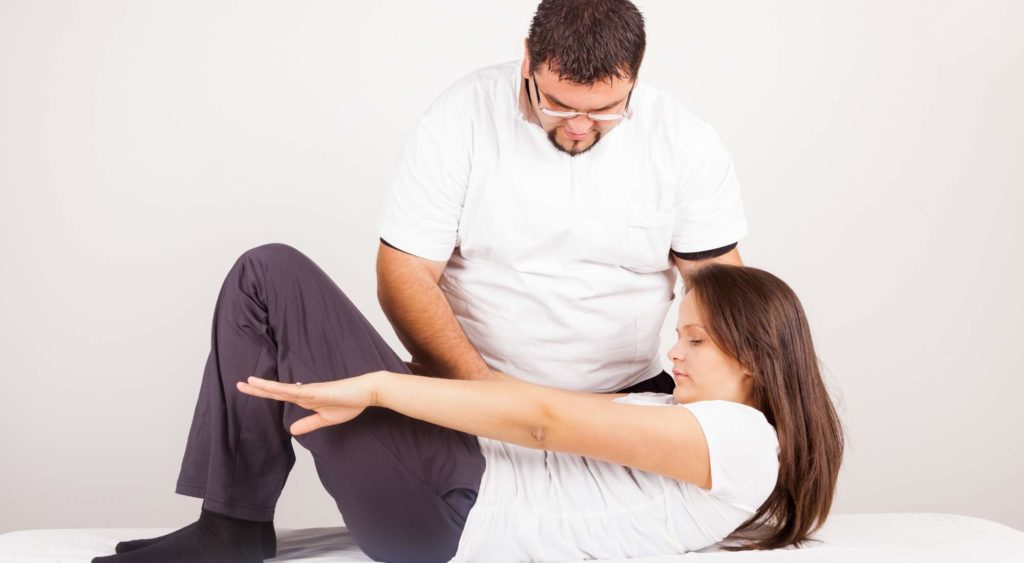
Scheduled for umbilical hernia surgery? Many patients are unsure of what to expect after the surgery as they get back to day-to-day activities; including one of the biggest concerns:
“Should I exercise after umbilical hernia surgery?”
We understand how frustrating and sometimes scary it can be to start a new exercise routine after dealing with an injury like an umbilical hernia.
Which is why we’re here to help. Keep reading to learn more about umbilical hernias, what to expect after umbilical hernia surgery, and how physical therapy can help you recover and prevent future injuries.
Table of Contents
- What Is an Umbilical Hernia?
- How Long Does it Take to Recover From an Umbilical Hernia Surgery?
- Post Umbilical Surgery Expectations
- How Do I Strengthen My Core After Umbilical Hernia Surgery?
- Visit In Motion O.C. for Your Post-Recovery Physical Therapy Needs
What Is an Umbilical Hernia?
If you’ve recently been told you’re dealing with an umbilical hernia, you might be wondering what that means.
Umbilical hernias happen when a section (usually a loop of fatty tissue or the bowel) of your intestine bulges through the opening of your abdominal muscles near your navel.
In babies and children, these are often painless and harmless but can be cause for concern if left untreated.
For adults, umbilical hernias tend to cause some discomfort in the abdomen — but if left undiagnosed or untreated, they can become a more serious condition.
Umbilicals hernias in adults are more common in females, especially those who have had multiple pregnancies; but umbilical hernias are also often found in people who:
- Are considered clinically overweight
- Consistently lift heavy objects; or
- Have a persistent cough
Symptoms of an Umbilical Hernia
Some of the most common symptoms of an umbilical hernia include:
- Swelling near the belly button
- Bulging near the belly button
- A bulging spot becomes larger or harder when straining — in babies, this can happen when they cry or laugh.
If symptoms of an umbilical hernia are persistent, the hernia may be causing a blockage of the intestines.
It is often recommended that adults dealing with an umbilical hernia seek treatment — usually surgery — to prevent any blockage from occurring or getting worse.
Umbilical hernia surgery is a quick procedure done by making a small incision near the base of the belly button, pushing the herniated tissue to where it belongs, and stitching the abdominal wall closed.
How Long Does it Take to Recover From an Umbilical Hernia Surgery?
Umbilical hernia surgery recovery time varies from person to person. Usually, a person who has surgery is in and out of the hospital within the same day as the procedure and can get back to “normal” daily activities within two weeks.
It is recommended that patients who have undergone an umbilical hernia surgery avoid any strenuous activity for at least six weeks.
Post Umbilical Surgery Expectations
You’re a candidate for surgery — you know that this is likely the best route for you and your health, but you’re curious about what you should expect before and after umbilical hernia surgery.
You might even be asking yourself, or your physician, things like:
- What should I be doing before and after surgery?
- Can I avoid a hernia from occurring again in the future?
- Are there certain exercises to do after umbilical hernia surgery?
- Should I start physical therapy after umbilical hernia surgery?
In the following sections, we touch on some of the most common concerns patients have after umbilical hernia surgery and what you can expect.
Is There Physical Therapy After Hernia Surgery?
Oftentimes, patients who have had a surgical procedure to remove an umbilical hernia are not encouraged or informed by their physician about going to physical therapy after hernia surgery.
But that doesn’t mean physical therapy isn’t necessary to ensure a hernia doesn’t reoccur.
What do we mean?
Adult patients who experience umbilical hernias may not have the core strength they need to perform activities they perform regularly. This is why an umbilical hernia may occur in the first place.
Physical therapy can be especially beneficial to help your core strength and control.
At In Motion O.C., our team of physical therapists can help you overcome weaknesses in your core and other problems that may contribute to the cause of your umbilical hernia. This will also prevent progressive issues, such as back pain or additional hernias, from occurring.
What Exercise Can I Do After Umbilical Hernia Surgery?
Generally speaking, light, everyday activities such as walking, bending, etc. can start in as little as a week after surgery but may cause some discomfort.
Your doctor may say you can get started back into an exercise routine in as little as two weeks, but it is important to understand that everyone is unique. It may take up to six to twelve weeks before you’re comfortable doing any strenuous activity or exercises.
Keep reading to learn some of the best exercises to do after umbilical hernia surgery to promote:
- Healing
- Core Strength; and
- Improved lung and bowel function post-surgery
Always consult your physician, or your physical therapist, before starting an exercise regime after umbilical hernia surgery to ensure exercises are done safely and correctly.
#1: Deep Breathing
Many patients want to take short, shallow breaths after umbilical hernia surgery to avoid aggravating the area. This can actually hurt your health instead of helping it. Shallow breathing can keep you from adequately inflating your lungs and increases your risk of lung infections.
Instead, practice deep breathing. Taking deep, full breaths throughout the day can help keep mucus out of your lungs.
If you’re scared of how you’ll feel while practicing deep breathing, try coughing carefully while holding a pillow on your abdomen for support.
#2: Gentle Walks
Walking after an umbilical hernia procedure (or any hernia surgery) is beneficial for several reasons, including:
- Keeping your muscles strong
- Helping your muscles return to the correct place
- Bringing blood to the site of the surgery; and
- Reducing risks of complications
You don’t have to walk miles at a time, either. Start slowly and take breaks as needed.
#3: Pelvic Tilts
Pelvic tilts are a great exercise to do to strengthen your core without putting excess pressure on your hernia site. To do pelvic tilts, you should:
- Sit on the edge of your bed or a chair.
- Tilt your pelvis backward, as if you’re about to lie down.
- Arch your lower back and tilt your pelvis forward.
- Repeat these steps in a back and forth rocking motion.
Do this exercise ten times several times a day.
#4: Core Twists
Core twists keep your torso flexible while also strengthening the muscles of your abdomen. Core twists promote healing by decreasing stiffness after surgery.
Core twists can be done by:
- Lying on your back and extending your arms straight out to the side — imagine your body is a plus sign.
- Bringing your feet towards your body until your knees are at a 90-degree angle.
- Lowering your knees as far to the right side of your body as you can without feeling uncomfortable. Keep the upper half of your body still and remain in this position for 20 seconds.
- Doing the same thing on the left side of your body.
Repeat this exercise three to four times daily.

How Do I Strengthen My Core After Umbilical Hernia Surgery?
Dealing with the discomforts from an umbilical hernia likely has you thinking,
“I never want to deal with this again!”
The key to preventing umbilical hernias is to strengthen your core.
And although the exercises we mentioned above can help regain some strength during recovery, learning how to work and use your core properly is the most beneficial thing you can do to:
- Heal post umbilical hernia surgery
- Prevent an umbilical hernia from recurring; and
- Reduce the risk of additional hernias from occurring
But, how can you ensure that you’re doing the right exercises the right way? Physical therapy after umbilical hernia surgery!
A licensed physical therapist can help you understand abdominal weaknesses and show you exercises that isolate and condition the area to prevent reinjury.
Post-Recovery Physical Therapy to Strengthen the Core and Prevent Further Complications
Avoid abdominal strain and injury by learning the proper techniques for lifting, exercising, and doing day-to-day activities by meeting with a physical therapist.
Your physical therapist can help you better understand body mechanics and how you should be doing everyday tasks.
Attending post-recovery physical therapy is one of the best ways for patients to …
- Rebuild
- Repair; and
- Strengthen
… your core and prevent injuries or complications from occurring in the future.

Visit In Motion O.C. for Your Post-Recovery Physical Therapy Needs
Whether you are preparing for umbilical hernia surgery or have already gone through surgery and are looking for physical therapy after umbilical hernia surgery, In Motion O.C.’s experienced physical therapists are here to help.
Rated as the number one physical therapy clinic in the United States on Yelp!, we’re committed to helping our patients heal, build confidence, and get back to enjoying their day-to-day activities pain-free.
Let us help you prevent future injuries from occurring by scheduling a consultation today.



